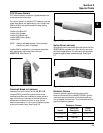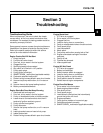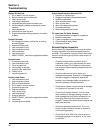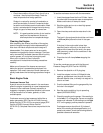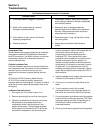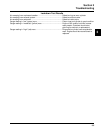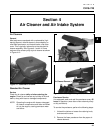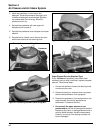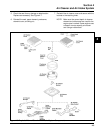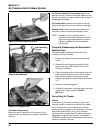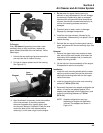
3.4
Section 3
Troubleshooting
Compression Test
Some of these engines are equipped with an automatic
compression release (ACR) mechanism. Because of
the ACR mechanism, it is difficult to obtain an accurate
compression reading. As an alternative, perform a
cylinder leakdown test.
Cylinder Leakdown Test
A cylinder leakdown test can be a valuable alternative
to a compression test. By pressurizing the combustion
chamber from an external air source you can
determine if the valves or rings are leaking, and how
badly.
SPX Part No. KO3219 (formerly Kohler Part No.
25 761 05-S) is a relatively simple, inexpensive
leakdown tester for small engines. The tester includes a
quick disconnect for attaching the adapter hose, and a
holding tool.
Leakdown Test Instructions
1. Run engine for 3-5 minutes to warm it up.
2. Remove spark plug(s) and air filter from engine.
3. Rotate the crankshaft until the piston (of cylinder
being tested) is at top dead center of the
compression stroke. Hold the engine in this
position while testing. The holding tool supplied
with the tester can be used if the PTO end of the
crankshaft is accessible. Lock the holding tool
onto the crankshaft. Install a 3/8" breaker bar into
the hole/slot of the holding tool, so it is
perpendicular to both the holding tool and
crankshaft PTO. If the flywheel end is more
accessible, use a breaker bar and socket on the
flywheel nut/screw to hold it in position. An
assistant may be needed to hold the breaker bar
during testing. If the engine is mounted in a piece
of equipment, it may be possible to hold it by
clamping or wedging a driven component. Just be
certain that the engine cannot rotate off of TDC in
either direction.
4. Install the adapter into the spark plug hole, but do
not attach it to the tester at this time.
5. Connect an air source of at least 50 psi to the
tester.
6. Turn the regulator knob in the increase
(clockwise) direction until the gauge needle is in
the yellow “set” area at the low end of the scale.
7. Connect the tester quick-disconnect to the adapter
hose while firmly holding the engine at TDC. Note
the gauge reading and listen for escaping air at
the carburetor intake, exhaust outlet, and
crankcase breather.
8. Check your test results against the following table:
Possible Cause
Solution
1. Disassemble breather, clean parts thoroughly,
check sealing surfaces for flatness, reassemble,
and recheck pressure.
2. Replace all worn or damaged seals and
gaskets. Make sure all fasteners are tightened
securely. Use appropriate torque values and
sequences when necessary.
3. Recondition piston, rings, cylinder bore, valves,
and valve guides.
4. Repair/replace restricted muffler/exhaust
system.
1. Crankcase breather clogged or inoperative.
2. Seals and/or gaskets leaking. Loose or
improperly torqued fasteners.
3. Piston blowby or leaky valves. (Confirm by
inspecting components.)
4. Restricted exhaust.
No Crankcase Vacuum/Pressure in Crankcase




